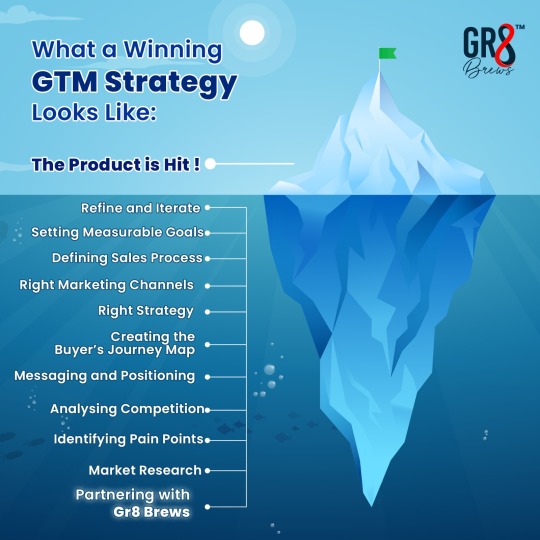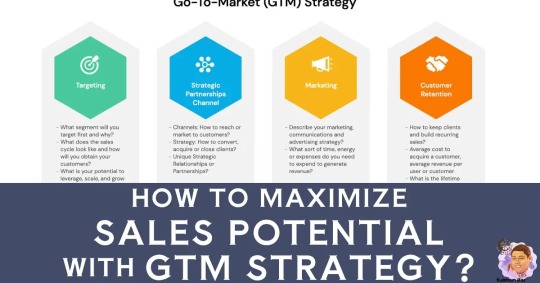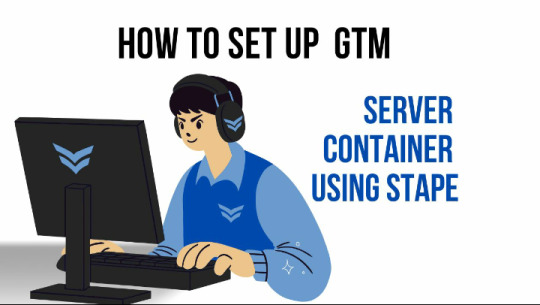#marketing and gtm strategy
Explore tagged Tumblr posts
Text
Via Marketing
Website: https://viamrkting.com/
1 note
·
View note
Text
Tuneer Malik on Regional Strategy, Field Marketing ROI, and MQL Precision
In the ever-evolving landscape of B2B marketing, leaders like Tuneer Malik, Head of APAC Marketing (GTM) at Glean, exemplify the fusion of strategic vision and tactical execution. With a career spanning over a decade, Malik has consistently demonstrated how regional strategies, precise field marketing, and meticulous lead qualification can drive substantial revenue growth.
Regional Strategy: Tailoring Approaches for Diverse Markets
In the vast and varied APAC region, a one-size-fits-all marketing approach falls short. Malik emphasizes the importance of customizing strategies to align with local cultures, business practices, and consumer behaviors.
Get full insights@ https://itechseries.com/interviews/field-marketing-roi/
By conducting in-depth market research and fostering local partnerships, Malik ensures that campaigns resonate with regional audiences. This localized approach not only enhances brand relevance but also drives higher engagement and conversion rates.

Field Marketing ROI: Measuring What Matters
Field marketing, often perceived as challenging to quantify, is a critical component of Malik's strategy. He advocates for a data-driven approach, setting clear KPIs such as lead generation, event attendance, and pipeline contribution to assess effectiveness.
By leveraging analytics tools and CRM systems, Malik tracks the performance of field initiatives in real-time. This transparency allows for agile adjustments, ensuring that resources are allocated to high-impact activities that drive revenue.
MQL Precision: Enhancing Lead Quality
Malik places a strong emphasis on refining Marketing Qualified Leads (MQLs) to ensure sales teams receive high-quality prospects. Through rigorous lead scoring models that consider engagement levels, demographic data, and behavioral indicators, Malik enhances lead qualification processes.
This precision reduces the sales cycle and increases conversion rates, as sales teams can focus their efforts on leads with the highest propensity to purchase. Regular collaboration between marketing and sales ensures continuous improvement of lead criteria and alignment on objectives.
Revenue Marketing: Aligning Marketing Efforts with Business Goals
Transitioning from traditional marketing to revenue marketing requires a shift in mindset. Malik champions this transformation by aligning marketing initiatives directly with revenue targets.
By integrating marketing efforts with sales objectives, Malik ensures that every campaign contributes to the bottom line. This alignment fosters accountability and demonstrates the tangible value of marketing within the organization.
Marketing Leadership: Cultivating High-Performance Teams
Effective marketing leadership involves more than strategic planning; it requires building and nurturing high-performing teams. Malik focuses on fostering a culture of innovation, collaboration, and continuous learning within his team.
By providing clear direction, empowering team members, and encouraging professional development, Malik ensures that his team remains agile and responsive to market changes. This leadership style not only drives team satisfaction but also enhances overall marketing effectiveness.
Explore the latest marketing and tech insights@ https://itechseries.com/gtm-library/
Integrating Technology: Leveraging Tools for Efficiency
Incorporating technology into marketing processes is essential for scalability and efficiency. Malik utilizes a suite of marketing automation tools, CRM systems, and analytics platforms to streamline operations and gain insights.
These technologies enable Malik's team to execute personalized campaigns at scale, monitor performance metrics, and make data-driven decisions. The integration of technology ensures that marketing efforts are both effective and efficient.
Continuous Improvement: Adapting to Market Dynamics
The B2B marketing landscape is dynamic, requiring constant adaptation. Malik advocates for a culture of continuous improvement, where strategies are regularly evaluated and refined based on performance data and market feedback.
By staying attuned to industry trends and customer needs, Malik ensures that marketing initiatives remain relevant and impactful. This proactive approach positions the organization to capitalize on emerging opportunities and maintain a competitive edge.
Thought Leadership: Establishing Authority in the Industry
Beyond executing campaigns, Malik contributes to the broader marketing community through thought leadership. By sharing insights, participating in industry events, and engaging in discussions on platforms like LinkedIn, he establishes authority and credibility.
This visibility not only enhances personal branding but also elevates the organization's profile, attracting potential clients and partners. Thought leadership serves as a powerful tool for building trust and influencing industry conversations.
Conclusion
Tuneer Malik's approach to B2B marketing—grounded in regional customization, data-driven field marketing, precise lead qualification, and strategic leadership—offers a comprehensive blueprint for driving revenue growth. By aligning marketing efforts with business objectives and fostering a culture of continuous improvement, Malik demonstrates how marketing can serve as a pivotal driver of organizational success.
#Field Marketing#B2B Marketing#Integrated Marketing Strategy#Revenue Marketing#Marketing Leadership#MQL Strategy#Marketing ROI#Demand Generation#GTM Strategy
0 notes
Text

can we agree

on the efficacy of pull vs. push marketing?
0 notes
Text

We make your life easier, help you achieve your dreams, and make it all look effortless. You just sit back & trust the process.
Visit Us : https://www.gr8brews.com/
#advertising#branding#marketing#digital marketing#360marketing#social media marketing agency#gr8brews#brands#creativity#trending#gtm#gtm strategy
0 notes
Text
Go-to-Market Strategy Checklist: Key Steps for Success

This infographic outlines the essential steps for a successful go-to-market (GTM) strategy, from market research and positioning to marketing execution. Follow this checklist to launch your product or service effectively and drive growth. Learn more at AndPurpose.
0 notes
Text
GTM Strategy for Efficient Sales and Marketing
Elevate your go-to-market strategy with advanced techniques, leveraging data-driven decision-making, automation, and Account-Based Experience (ABX) for efficient sales and marketing. Continue reading to learn more. Advanced GTM Strategy TechniquesData-Driven Decision-MakingAutomationAccount-Based Experience (ABX)Best Practices for a Successful GTM StrategyKey FacetsStakeholder…

View On WordPress
#business strategy#sales#startup#GTM strategy#go-to-market strategy#sales and marketing#efficient sales#marketing strategy#sales optimization#market entry#sales growth#revenue growth#customer acquisition#sales process#marketing plan#business growth#market research#sales tactics#marketing tactics#market penetration#sales funnel#marketing funnel#lead generation#customer journey#target market#marketing alignment#sales alignment#GTM plan#product launch#sales strategy
1 note
·
View note
Text
How to Create a Custom GTM Strategy by Asking the Right Questions? How to create a custom Go-to-Market strategy for your product’s success by addressing the right questions

0 notes
Text
FMCG Business Strategy: Comprehensive Guide for Sustainable Growth
Explore the intricacies of FMCG business strategy for sustainable growth. Discover key components like product innovation, pricing, distribution, and successful case studies in this guide.
#FMCG Business Strategy#Fast-Moving Consumer Goods#FMCG#FMCG companies#FMCG business strategy#FMCG business#Go-To-Market strategy#GTM strategy#FMCG products#Digital marketing#FMCG industry#Go-To-Market Strategy Consulting#Go-To-Market strategies#FMCG consultancy firms#FMCG Pricing Strategy#FMCG consultants#CPG Consulting firms#Strategii At Work
0 notes
Text
Challenges that marketers face during AI adoption
Interesting read on Marketing challenges.
As marketers embrace the transformative power of artificial intelligence (AI), they encounter various challenges that come with integrating this advanced technology into their strategies. Here are 10 challenges that marketers commonly face with AI: Data Quality and Integration: Challenge: AI relies heavily on data, and ensuring the quality, accuracy, and integration of diverse data sources can…

View On WordPress
0 notes
Text
Tuneer Malik on Regional Strategy, Field Marketing ROI, and MQL Precision
In the ever-evolving landscape of B2B marketing, leaders like Tuneer Malik, Head of APAC Marketing (GTM) at Glean, exemplify the fusion of strategic vision and tactical execution. With a career spanning over a decade, Malik has consistently demonstrated how regional strategies, precise field marketing, and meticulous lead qualification can drive substantial revenue growth. Regional Strategy:…
#B2B Marketing#Demand Generation#Field Marketing#GTM Strategy#Marketing Leadership#Marketing ROI#MQL Strategy#Revenue Marketing
0 notes
Text
#gtm strategy#foxnangel#india market entry#business expansion#foreign direct investment#investment opportunities#fdi in india#indian market#foreign investments#invest in india
0 notes
Text
Round 1 results
Rules
Round 1 of voting is now over !

It appears we have only become used to the various Cosette photoshoping as a marketing strategy, because the three posts that unquestionably took the lead here are :
The "Who should Marius choose ??" question
Mother's day post
Cosette celebrating Thanksgiving
Joining those three in Round 2, we have two more posts that win by a more narrow margin :
The barricades on Christmas Eve
and of course, the one and only Wimbledon post
The second round to create a podium with those 5 posts will begin at midnight GTM and will last until January 8th.
The last five Cosette posts did not make it in the top 5 but will all get an honorary mention when the final ranking will be made !
Links to the posts participating in this tournament :
The "Who should Marius choose ??" question - source : Twitter - January 29th
Mother's day post - source : Twitter - March 19th
The Easter post - source : Twitter - April 9th
Fourth of July post - source : Twitter - July 4th
The Wimbledon post - source : Twitter - July 15th
Football World Cup - source : Twitter - August 20th
Cosette in San Diego - source : Twitter - October 15th
Thanksgiving - source : Twitter - November 23rd
Christmas Eve - source : Twitter - December 24th
Christmas - source : Twitter - December 25th
15 notes
·
View notes
Text

📢 Calling All Marketers & eCommerce Owners!
Want to gain full control over your data and boost tracking accuracy? 🚀
Set up a GTM Server Container with Stape in just a few steps:
Here's How:
✅ Create a GTM Server Container.
✅ Deploy it on Stape (it’s hassle-free!).
✅ Update your website tracking code to use server-side tagging.
💡 Why switch to server-side tagging?
Enhanced data security.
Faster website load times.
Better analytics accuracy.
👉 Ready to take control of your data? Let’s get started!
Watch video https://youtu.be/ew15CMSsaLg
Check our website https://www.digitaldebashreedutta.com/ultimate-gtm-data-layer-for-shopify/
To get our service click here https://www.digitaldebashreedutta.com/digital-marketing-agency/
🌐 Are you a Blogger, Marketer, or YouTuber on the hunt for game-changing marketing tools? Look no further! Unlock a treasure trove of tools to supercharge your strategies and reach new heights of success. 💼✨
💻 Quick link to powerful tools: http://linkst.in/debashreedutta00
But that’s not all! 🔥 Connect with me, Debashree Dutta, on social media to stay ahead with the latest trends, insights, and more. Let’s build your digital journey together:
🌐 Discover it all on my Linktree: https://linktr.ee/digitaldebashreedutta
💥 Don’t miss out—tap into these extraordinary tools now! Elevate your marketing game, stay smart, and let’s conquer the digital world! 🚀📈 #DigitalMarketing #MarketingTools #DebashreeDutta
#GoogleTagManager #StapeHosting #eCommerceHacks
2 notes
·
View notes
Text
okah I had that interview with my old job (if you can call it that, since they had no intention of recruiting me and I have no desire to return) and it was certainly illuminating lol. under a cut in case you don't give a shit about corporate nonsense but it's funny I promise
what it comes down to is that the role is "different" now in two key ways: (1) they want someone who currently is or has been a software engineer but also is a technical writer, and who'll start out as an IC and the only member of the team but will eventually scale up to grow the team and become a manager, and (2) has experience working directly with product teams, UX writing, GTM strategy, etc.
re. point two I mentioned that not only are those all things I did (because they're common things that most TWs do), but that they're listed on my resume almost verbatim, which is why linkedin kept telling me I'd be a good fit for the job, and re. point one I was frank and said that like, not only did the job posting itself not convey that at all (because again, I kept getting recommended for it, and everything else in the listing was bog standard TW shit), but basically Good Fucking Luck finding someone who fits that bill lmao. not that "engineer turned technical writer" is unheard of, but it's not the most common path people take, and especially in this job market I'm inclined to think that someone with an engineering background would gravitate towards jobs that pay an engineering salary (i.e., higher than that).
the person I spoke with was pretty receptive about the job listing feedback and said that she didn't write it, the VP of Whoever did, and that they have had quite a few candidates who match the skillset/background they're looking for but I'm skeptical. not to mention how they're not "officially" requiring it to be a hybrid role but they're trying to hire people "who are near the office," whatever that means.
in any case, this confirms all my suspicions about how waterlogged this company's hull currently is, and I wish all the best to whoever lands this role and finds themselves with way more responsibilities than they bargained for. god knows how overwhelmed I was by the end, even with three years of institutional knowledge under my belt. I can only hope the excellent readme files I left behind will make it easy for them to parse my docs toolchain.
also this was a great learning opportunity for me to realize that people suck at communicating what they want—which, okay, I knew that already, but like specifically for job postings. there are soooo many reasons you can apply to a job that perfectly matches your experience and get insta-rejected anyway, but it hadn't occured to me that "they actually want something totally different from what they wrote" could be one of them lol. and then I guess the flip side of that is how you can apply to a job posting and then wind up in a role that's not at all what was advertised. although that is one of the things you should try to sniff out ahead of time in an interview. so watch out I guess
16 notes
·
View notes
Text
Boost Your Business with Facebook Conversion API & GTM Server-Side Tracking
In the ever-evolving world of digital marketing, data-driven strategies are key to success. Facebook's Conversion API combined with Google Tag Manager (GTM) server-side tracking and GA4 offers a powerful way to maximize your ad performance and accurately track user behavior. >>>ORDER NOW<<<

I specialize in setting up Facebook Conversion API with GTM server-side tracking, allowing you to bypass ad blockers, reduce data loss, and improve tracking accuracy. This ensures that your Facebook pixel data is sent directly from your server to Facebook, giving you deeper insights into user interactions. >>>ORDER NOW<<<
Key benefits:
Enhanced data accuracy
Improved ad targeting
Reduced ad blocker limitations
Get the most out of your ad campaigns by setting up your Facebook Conversion API today and start tracking with precision!
#artists on tumblr#deadpool and wolverine#dungeon meshi#formula 1#gravity falls#hatsune miku#free palestine#bill cipher#dipper pines#epic the musical
2 notes
·
View notes
Text
Google Ads Campaign Management || Google Analytics & GTM Specialist
It's great to hear about your extensive experience in digital marketing and the wide range of services you offer, including Google Ads, Google Analytics GA4, and Tag Manager services. Your expertise in these areas can be extremely valuable to small business owners and start-ups looking to establish a strong online presence. Here's a summary of your services: **Google Ads Management Services**: - Google Ads Campaign Setup - Advanced Keyword Research - Google PPC Ads Extension Setup - Conversion Tracking & Analytics Setup - Audience Optimization and Budget Setup - Comprehensive Optimization Strategies - Campaign Strategy Reports **Google Analytics 4 & Google Tag Manager Services**: - Google Analytics (GA4) Setup - Google Tag Manager (GTM) Setup - Goals Cross-Domain & Events Tracking - Form, E-commerce, and Purchase Tracking - Custom Audience & Remarketing - Social Ads Conversion Tracking Setup - Google Ads Conversions Tracking - Website Interaction Tracking - Custom Reports and Filters - Pixel Installation for Remarketing Tags - Integration with Various Pixels (e.g., Hotjar, Facebook, Twitter, Pinterest, LinkedIn) **Facebook Services**: - Facebook Pixel Installation - Google Tag Manager Setup for Facebook - Facebook Conversion API Setup - Server-Side Tracking - Domain Verification - iOS 14 Update Compliance - Shopify Facebook Pixel Tracking - E-commerce Conversion Tracking - Aggregated Event Measurement - GA4 Measurement ID Installation **GTM Server-Side Tracking Services**: - Server-Side Tracking for Various Platforms and Pixels You work with a variety of website platforms, including WordPress WooCommerce, Shopify, Wix, ClickFunnels, Laravel/PHP, and custom websites, making your services adaptable to different clients' needs. It's also nice to know a bit about your personal life and interests. Your pursuit of a Master's Degree in Digital Marketing demonstrates your commitment to staying up-to-date in the field. And as a cat lover and traveler, you bring a personal touch to your professional profile. Your comprehensive range of services and your commitment to ongoing education make you a valuable asset in the digital marketing industry. I wish you the best of luck in your endeavors, and I hope your skills continue to benefit your clients and your academic pursuits. Best Regards! #digitalmarketingagency #spotify #wordpress #tracking #beauty #portrait #teenage #googleads
#google tag manager#baby animals#facebook ads#facebook pixel#google analytics#google ads#puppies#kittens#kitty#maia arson crimew
2 notes
·
View notes